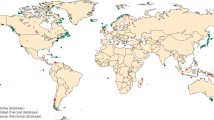Summary
A historic analysis of human-initiated influences on the Falkland Islands ecologies is presented. Ecosystems were extensively altered by the destruction of seal and penguin communities in the late eighteenth and nineteenth centuries; and by the introduction of domesticated animals and exotic plants, the proliferation of fires, and the hunting to extinction, or near extinction, of certain animals. The harsh Falklands climate has permitted only limited recovery from some of these ravages. No island ecosystems, however remote, are spared the effects of economic and political changes influencing the rest of the world.
Similar content being viewed by others
References
Abbott, C.C., 1861. Notes on the birds of the Falkland Islands.Ibis,1, 149–167.
Aidie, R.J. 1952. The position of the Falkland Islands in a reconstruction of Gondwanaland.Geological Magazine,89, 401–410.
Anon, 1992.Agricultural Statistics 1989–90. Department of Agriculture. Stanley, Falkland Islands.
Armstrong, P.H. 1982. Rabbits (Oryctolagus cuniculus) on islands: a case-study of successful colonization.J. Biogeography,9, 353–362.
Armstrong, P.H. 1992a. Human impacts on Australia's Indian Ocean island ecosystems, a review.The Environmentalist,12 (3), 191–206.
Armstrong, P.H. 1992b.Darwin's Desolate Islands: A Naturalist in the Falklands, 1833 and 1834. Picton Publishing, Chippenham.
Bayliss-Smith, T.P. 1977. Human ecology and island populations: the problems of change;and Energy use and economic development in Pacific communities. In: Bayliss-Smith, T.P. and Feachem, R.G. (eds),Subsistence and Survival: Rural Ecology in the Pacific pp. 11–20 and 317–359. Academic Press, London and New York.
Bertrand, K. 1991. Camp life in the Falklands — a series of sketches.Falkland Islands Journal,5(5), 7–18.
Bynoe, B. 1833. Remarks upon the Falkland Islands, particularly near the settlement at Port Louis, March, 1833. Document in Archives Section, Hydrographic Department, Taunton.
Byron, J. 1814. An account of voyage round the world in the years 1764, 1765 and 1766 ... in His Majesty's ShipDolphin. In: Kerr, J. (ed.),Voyages,12, pp.9–119.
Carstairs, D.N. 1990. A review of the occurrence of the fritillary butterfly (Issoria cytheris cytheris) in the Falkland Islands.Falkland Islands Journal,5(4), 16–20.
Cobb, A.F. 1910.Wild Life in the Falkland Islands, London and Glasgow.
Cunningham, R.O. 1871.The Natural History of the Straits of Magellan Made During the Voyages of HMS Nassau,1866–69. Edinburgh.
Darwin, C.R. 1845.The Voyage of the Beagle. J. Murray, London.
Darwin, C.R. and Gould, J. 1841.The Zoology of the Voyage of the Beagle, Part 3,Birds. Smith and Elder and Co., London.
Darwin, C.R. and Jenyns, L. 1842.The Zoology of the Voyage of the Beagle, Part 4,Fish, Smith and Elder and Co., London.
Darwin, C.R. and Waterhouse, G.R. 1839.The Zoology of the Voyage of the Beagle, Part 2,Mammalia. Smith and Elder and Co., London.
Davidson, J. 1938.Transactions of the Royal Society of South Australia,62, 342–346.
Elton, C.S. 1966.The Pattern of Animal Communities. Methuen, London.
Fanning, E. 1834.Voyages and Discoveries in the South Seas. London.
Fosberg, F.R. 1957. The island ecosystem. In: Fosberg, F.R. (ed.),Man's Role in the Island Ecosystem. Bishop Museum Press, Honolulu, Hawaii.
Gade, D.W. 1985. Man and nature in Rodrigues: tragedy of an island common.Environmental Conservation,12(3), 207–235.
Gennard, D.J. and McAdam, J.H. 1987. A pollen profile from tussac peat. Sealion Island, East Falkland.The Warrah,3, 4–7.
Hardison, J.R. 1976. Fire and flame for disease control.Annual Review of Phytopathology,14 355–379.
Hooker, J.D. 1847.Botany of the Antarctic Voyage, Vol. 1Flora Antarctica, Part 2,The Botany of Fuegia, the Falklands, etc. Reeve, London.
Hubbard, C.E. 1937. Sand-binding grasses in the Falkland Islands.Bulletin of the Royal Botanical Gardens, Kew,4, 274.
Jones, A.G.E. 1992. Fur sealing in the Falkland Islands in the 1820s and 1830s.Falkland Islands Journal,6(1), 39–47.
McAdam, J.H. 1980. Uncontrolled grazing and vegetation removal in the Falkland Islands.Environmental Conservation,7, 201–202.
McAdam, J.H. 1984. The introduction ofHolcus lanatus by direct drilling following burning of native grassland in the Falkland Islands.Research and Development in Agriculture,1, 165–169.
McAdam, J.H. 1989. The great fire on Keppel Island, 1855.Falkland Islands Journal,5(3), 23–28.
McDowall, R.M. and Nakaga, K. 1987. Identity of Galaxid fishes of the genusAplochiton Jenyns, from Southern Chile.Japanese Journal of Ichthyology,34, 377–383.
Mitchell, C., Taylor, G.K., Cox, K.G. and Shaw, J. 1986. Are the Falkland Islands a rotated microplate?Nature,319, 132–135.
Moore, D.M. 1968. A vascular flora of the Falkland Islands.British Antarctic Survey Scientific Reports, No. 60.
Mowat, J.T. 1896. Letter from theMarlborough Express quoted inFalkland Islands Journal,1(3), 33–35.
Pernety, A.J. 1770.Histoire d'un Voyage aux l'lsles Malouines. Paris.
Smith, C.H. 1839. Dogs: or genus Canis of authors. In: Jardine, W. (ed.),Naturalists Library, Lizars, Edinburgh.
Smith, R.I.L. and Prince, P.A. 1985. The natural history of Beauchêne Island.Biological Journal of the Linnean Society,24, 233–283.
Snow, W.P. 1857.Snow's Voyages to the South Seas and Tierra del Fuego. Longman, London.
Stoddart, D.R. 1968. Catastrophic interference with coral atoll ecosystems.Geography,53(1), 25–40.
Strange, I.J. 1976.The Bird Man. Gordon Cremonesi, London.
Strange, I.J. 1983.The Falkland Islands, 3rd edn. David and Charles, Newton Abbot, UK.
Strange, I.J. 1987.The Falkland Islands and their Natural History, David and Charles, Newton Abbot.
Way, P. 1983. Unexploded nightmare.The Falklands War,14, 421–423.
Way, P. (ed.). 1984.The Falklands: The Aftermath. Marshal Cavendish, London.
Wilson, P., Clark, R., McAdam, J.H. and Coper, E.A. 1993. Soil erosion in the Falkland Islands: a preliminary assessment.Applied Geography,13 329–352.
Woods, R.W. 1988.Guide to the Birds of the Falkland Islands. Anthony Nelson, Oswestry.
Author information
Authors and Affiliations
Additional information
He has published a previous article on island ecologies inThe Environmentalist (1992).
Rights and permissions
About this article
Cite this article
Armstrong, P.H. Human impact on the Falkland Islands environment. Environmentalist 14, 215–231 (1994). https://doi.org/10.1007/BF01907141
Issue Date:
DOI: https://doi.org/10.1007/BF01907141




